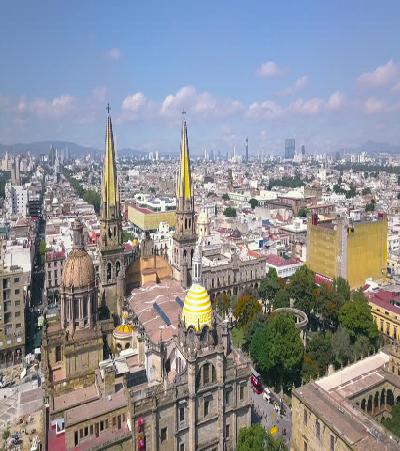 The city of Guadalajara is located almost in the heart of Spain, just fifty kilometers from the capital, on the Henares River. It was built by the Arabs in the 7th century, when they ruled these lands. The settlement's first name sounded like Wady al-Hiyara, which translated from Arabic to Spanish would mean "Valley of the Stones". The ancient Romans called it Arriaca ("The River of the Stones"). They were later expelled from this area by the Visigoths. Since then the city has left as a historical legacy some architectural monuments, in whose construction they actively participated. They are the ones that first attract tourists from all over the world here.
The city of Guadalajara is located almost in the heart of Spain, just fifty kilometers from the capital, on the Henares River. It was built by the Arabs in the 7th century, when they ruled these lands. The settlement's first name sounded like Wady al-Hiyara, which translated from Arabic to Spanish would mean "Valley of the Stones". The ancient Romans called it Arriaca ("The River of the Stones"). They were later expelled from this area by the Visigoths. Since then the city has left as a historical legacy some architectural monuments, in whose construction they actively participated. They are the ones that first attract tourists from all over the world here.
In 1085, Alfonso VI's army conquered the settlement, after which its active development began. It became a city in 1460 thanks to the Marqués de Santíllán López de Mendoza, who had begun to govern Guadalajara ten years earlier. In 1475, the Ducal Palace and the Temple were completed.
In the 17th century, the Mendoza family settled in Madrid and life in the city gradually declined. In the 18th century, Archduke Charles sacked Guadalajara with his troops, then Napoleon did the same. The rest of the valuables were removed from the city by Juan Mendizabal.
In the 19th century, a railway was built here. In 1923, there was a great fire. When Spain was in civil war, Guadalajara was completely destroyed. Now he enjoys the third highest standard of living in Spain.
The Arab Bridge:
The Arab Bridge is a viaduct that is 11 centuries old, but not to worry: it is working properly. Cars also pass over the bridge, and in the surroundings are rows of pretty country houses.
The quarterdeck:
The Alcázar built by the Arabs in the IX-X centuries. This fortress was often rebuilt, and at different times had a different purpose. The textile factory, the school for orphans, the military headquarters were located here. The historical monument was severely damaged during the Civil War and is still being rebuilt.
The Palace of the Dukes of Infantado:
The Palace of the Dukes of Infantado is a building that was considered a symbol of illumination, nobility and wealth in the Middle Ages. It is really very beautiful and looks like a malachite coffin.
Concordia Park:
Parque de la Concordia is a pleasant park, founded in the 19th century. To get here, walk from the Church of San Jinés on the Via Paseo del Capitán. The park used to occupy a huge area, but it had to be significantly reduced as modern streets were built. It is full of life, with alley racers and various games. Tourists, tired of sightseeing, can relax under the shade of the trees surrounded by beautiful flower beds.
Co-Cathedral Church of Santa María la Mayor:
This cathedral was built on the site of an old Arab mosque. The church itself was built in the 14th century and two centuries later there were chapels, a portico and an altar.
Pantheon of the Duchess of Seville:
Pantheon of the Duchess of Seville. Doña María Diega, in whose honor it was built, was not related to the influential Mendoza family. When the girl was three years old, she received a great fortune from her family, the Dukes of Seville. As an adult, Maria never married. The woman dedicated her life to charity, helping her hometown and its residents. Later, the Duchess's tomb was erected here, and all citizens came to see her on her last trip in 1916.
Provincial Museum:
This museum has a good collection of cultural and artistic objects. A selection of religious paintings is a special pride.
The Convento de la Piedad was founded in 1526. Inside the temple is the tomb of Brianda de Mendoza, who became its founder. The highlight of the church is the Plataresco façade, decorated with the coat of arms of the old Mendoza family.
